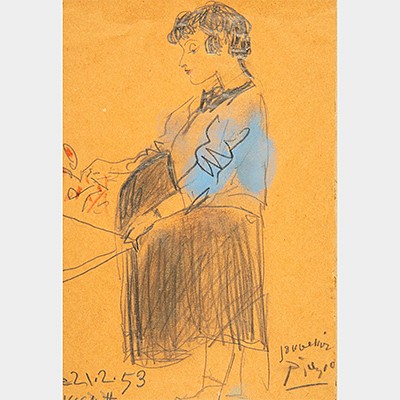JOAN MIRÓ (Barcelona, 1893 - Palma de Mallorca, 1983). "Femme", 1977. Mixed media on paper. Metal and graphite. Attached certificate issued by Adom.
Lot 75
About Seller
Setdart Auction House
Carrer Aragó 346
Barcelona
Spain
Setdart Subastas was born in 2004 and is currently the first online art auction in Spain with solidity, prestige and reliability guaranteed by our more than 60,000 users. Setdart has a young, dynamic and enterprising team ready to successfully manage the purchase and sale of art works through custom...Read more
Categories
Estimate:
EUR€30,000 - EUR€35,000
$32,608.70 - $38,043.48
Absentee vs Live bid
Two ways to bid:
- Leave a max absentee bid and the platform will bid on your behalf up to your maximum bid during the live auction.
- Bid live during the auction and your bids will be submitted real-time to the auctioneer.
Bid Increments
| Price | Bid Increment |
|---|---|
| EUR€0 | EUR€10 |
| EUR€200 | EUR€25 |
| EUR€500 | EUR€50 |
| EUR€1,000 | EUR€100 |
| EUR€3,000 | EUR€200 |
| EUR€5,000 | EUR€500 |
| EUR€10,000 | EUR€1,000 |
| EUR€20,000 | EUR€2,000 |
| EUR€50,000 | EUR€5,000 |
About Auction
By Setdart Auction House
Sep 20, 2021
Set Reminder
2021-09-20 08:00:00
2021-09-20 08:00:00
America/New_York
Bidsquare
Bidsquare : CONTEMPORARY ART
https://www.bidsquare.com/auctions/setdart-auction-house/contemporary-art-7482
Setdart Auction House sofia@setdart.com
Setdart Auction House sofia@setdart.com
- Lot Description
JOAN MIRÓ (Barcelona, 1893 - Palma de Mallorca, 1983). "Femme", 1977. Mixed media on paper. Metal and graphite. Attached certificate issued by Adom. Signed in the central right area. Dated ('25 / XI / 77) and titled on the back. Measurements: 37 x 29.3 cm; 63 x 51.5 cm (frame). Provenance: - Artist's workshop. - Pilar Juncosa Iglesias, Palma de Mallorca (by succession). - Acquired by private collection in the 80s. - Christie's. Sale 19966. Lot 307 from an important Spanish private collection. - Private collection, Madrid. With his idiosyncratic style, Miro depicts the body of a woman in this work. A piece in which he combines his light strokes with collage, introducing an element that simulates the features of the woman's face. The fine, delicate lines take up almost all the space, thus conceiving a rounded, suggestive female figure. The capture of the female body was a constant in the work of the artist, who worked on this theme through various formats, investigating his own aesthetics, in such a way that a great diversity in the representation of the concept of woman can be appreciated in works such as "Femme", which is in the collection of the Reina Sofia Museum in Madrid (1983), or the sculpture "Dona y Pajaro", which is in the Joan Miró Park in Barcelona. Joan Miró trained in Barcelona, between the Escola de la Lonja and the Galí Academy. In early 1918 he held his first exhibition at the Galeries Dalmau in Barcelona. In 1920 he moved to Paris and met Picasso, Raynal, Max Jacob, Tzara and the Dadaists. There, under the influence of the surrealist poets and painters, he gradually matured his style; he tried to transpose surrealist poetry to the visual, based on memory, fantasy and the irrational. From this point onwards his style began to evolve, leading him to more ethereal works in which organic forms and figures were reduced to abstract dots, lines and patches of colour. In 1924 he signed the first Surrealist manifesto, although the evolution of his work, which is too complex, makes it impossible to ascribe him to any particular orthodoxy. His third exhibition in Paris in 1928 was his first great triumph: the Museum of Modern Art in New York acquired two of his works. He returned to Spain in 1941, and that same year the museum devoted a retrospective to him which was to be his definitive international consecration. During the 1950s he experimented with other artistic media, such as engraving, lithography and ceramics. From 1956 until his death in 1983, he lived in Palma de Mallorca in a sort of internal exile, while his international fame grew. Throughout his life he received numerous awards, such as the Grand Prizes at the Venice Biennale in 1954 and the Guggenheim Foundation in 1959, the Carnegie Prize for Painting in 1966, the Gold Medals of the Generalitat de Catalunya (1978) and of the Fine Arts (1980), and was named Doctor Honoris Causa by the universities of Harvard and Barcelona. His work can currently be seen at the Joan Miró Foundation in Barcelona, inaugurated in 1975, as well as in major contemporary art museums around the world, such as the Thyssen-Bornemisza, the MoMA in New York, the Reina Sofía Museum in Madrid, the National Gallery in Washington, the MNAM in Paris and the Albright-Knox Art Gallery in Buffalo.
- Shipping Info
-
In-house shipping available. Please inquire at admin@setdart.com.
-
- Buyer's Premium



 EUR
EUR CAD
CAD AUD
AUD GBP
GBP MXN
MXN HKD
HKD CNY
CNY MYR
MYR SEK
SEK SGD
SGD CHF
CHF THB
THB









